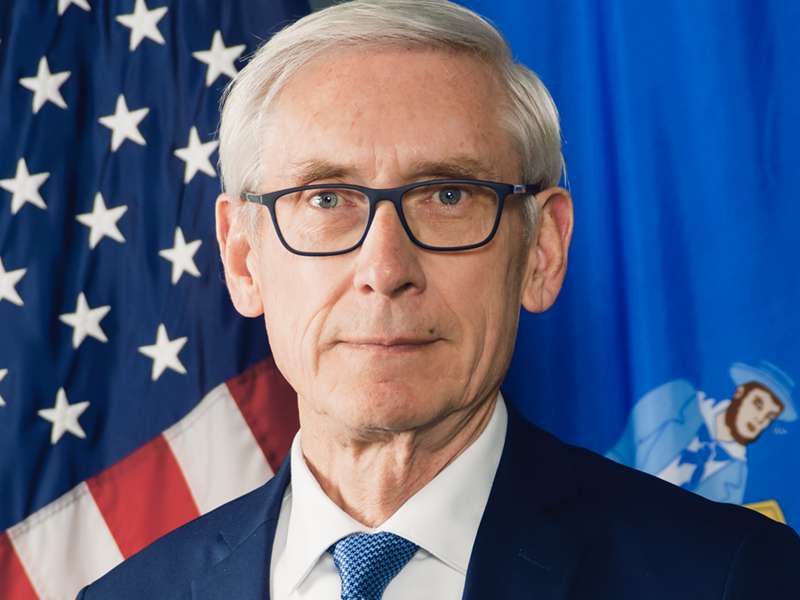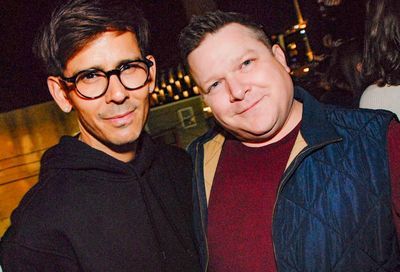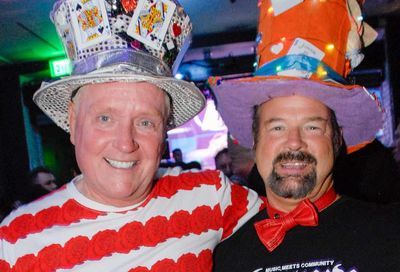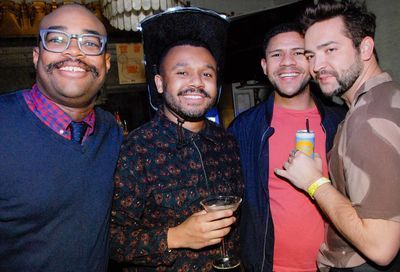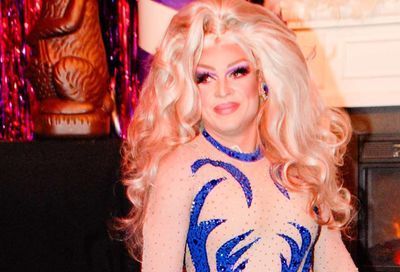Why Philadelphia’s Rocky Statue Resonates with the World
Paul Farber, director of Monument Lab and host of "The Statue," on Philadelphia's famed Rocky statue and what comprises a monument.

“The thing about monuments,” says Paul Farber, “is that there is no coherent set of monuments.”
Farber knows. As one of the country’s foremost experts on the subject of America’s monuments, great and small, and the co-founder and director of the Philadelphia-based Monument Lab, he has a deeper, more complex worldview of the statues and structures that the rest of us sometimes take for granted.
“It is a common misconception that there is some government agency out there in charge of all the monuments and they greenlight them and take the bad ones away,” says the youthful 40-year-old. “The truth is nothing like that.”
It is the day before Super Bowl LVII, in which the Kansas City Chiefs are set to do battle with the Philadelphia Eagles. Farber, a native Philadelphian, and longtime sports fan, has hopped on a Zoom call to not only discuss the meaning of our nation’s monuments in a fascinating deep dive, but to talk about the importance of one of Philadelphia’s most beloved structures: The statue of Rocky Balboa.
Originally constructed as a prop for the 1982 film Rocky III, the statue — which Farber notes is a monument to “the most famous Philadelphian who never lived” — has an almost uncanny, magnetic draw. It’s a touchstone for Philadelphians and tourists alike, drawing more annual visitors than the city’s fabled Liberty Bell.
Farber recently launched a six-part NPR narrative podcast about the Rocky statue entitled, appropriately enough, “The Statue,” which will air its sixth and final episode this Tuesday, Feb. 14.
“When you look at the story as we do in the podcast, you have a spotlight on Stallone, but actually, it’s the people around the story and around the statue,” he says. “We interview refugees from Afghanistan who [chose to live in] Philadelphia because of Rocky. We talked to harm-reduction organizers in Philadelphia in the neighborhood that the film was shot in, who see themselves — as one woman called herself from Operation Save Our City — as Rocky’s little sister. We talked to artists who live in areas where Rocky was shot. There’s really important stories that are being told that could never be captured in the film itself.
“For our podcast, we wanted to understand what is meaningful about this statue that is singular and unique — and not just about Philadelphia,” he continues. “I’ve been in other countries and I say I’m from Philadelphia and my cab driver in Germany says, ‘Rocky,’ as his word, as his connection.”
Farber, who identifies as queer, would like to see more monuments arise to commemorate the LGBTQ community’s history and causes. In some cases, the seeds are already sown.
“There are certainly places where LGBTQ history is honored,” he says. “I was just in L.A. last week, and there are several community parks in West Hollywood that celebrate important queer figures. There’s a National Park status outside of Stonewall [in New York]. There are moves in New York City to build new monuments to Marsha P. Johnson and other LGBTQ leaders.
“But the fact remains that when we look at the top 50 figures who have monuments dedicated to them, there are no self-identified LGBTQ+ people. Which tells us that while we’re making inroads and we know that we have a history and a presence in this country, our monuments don’t match that.”
METRO WEEKLY: Let’s start with what sparked your personal interest in monuments.
PAUL FARBER: I became interested in monuments by spending time walking around cities — understanding cities as places where we innovate toward the future and also are haunted by the past.
Sometimes stories of the past live on pedestals or plaques, but the most dynamic forms of history I’ve encountered are from art and protest, and narratives. So monuments became a way to point to stories of the past. But when you animate them with other forms of expression, they come to life in new ways.
Also for every monument that’s in the spotlight, there are countless others that we pass by every day without thought. We think about what does it mean to inherit monuments and what would it mean to imagine and unearth new ones?
MW: How do you define what a monument is?
FARBER: Monument Lab defines monuments as statements of power and presence in public. We came up with that definition in conversation with tens of thousands of people in public spaces across this country. And it’s meant to include bronze and marble symbols elevated above our heads, as well as forms of expression, public art, projection, poetry, and protests that also are monumental in their own ways.
We came up with that definition because there is no one single definition of monument. When you talk about monuments in our country, of course, you may be alluding to statues, but you also could be talking about historic sites, ecological sanctuaries, ruins.
And sometimes monuments — or things that are considered monumental — are not constructed per se, but they are the gatherings of people in protest, in vigil. So when you take an expanded view, you actually understand there is no single definition of a monument that satisfies everyone. It’s been a place where battles over power, representation, and belonging have taken place.
MW: So when the AIDS Quilt was fully displayed on the Mall in the 1990s, that qualifies as a monument by your definition.
FARBER: Absolutely it fits our definition of a monument. When you look at the history of the Quilt, you have people who, as it was being unfurled, thought of it as a profoundly healing gesture. Some thought of it as a profoundly political act. Others thought it wasn’t political enough, and so you actually have a multiplicity of voices, which should be the case of any site of memory.
At the same time, now we’re looking a generation later, and elements of the AIDS Quilt are collected in the Smithsonian and papers in the Library of Congress. So you have something that aimed to disrupt the status of the Mall in order to call attention to the importance of its activism and survival that is now part of our history.
Monuments we have inherited are not static and timeless. They all change something. The AIDS Quilt and the activism that surrounded it remind us of the powers that shape and push our history in really meaningful ways.
We’re often told that monuments are places of triumph and celebration. And when you look closer, you actually see that, whether it’s from the past or the present, there are also spaces where people are working out their grief, their loss, their trauma. In a society that’s bursting at the seams with loss and with grief, we are constantly looking for places to celebrate our victories, small and big, as well as come to terms and grips with our condition.
This is not the case with most monuments, let’s be clear. Most monuments are kind of afterthoughts. They’re like the furniture in your living room that you forgot is there and is covered in dust. But there are certain ones in rare instances that become places of collectivity where you work out the range of emotions that as a society we face.
MW: One of the things I was thinking about ahead of this interview was the recent movement to remove all statues of Confederate War — I don’t want to call them heroes.
FARBER: Traitors. Traitors to the United States. People who fought to dissolve the Union.
MW: I’m totally in agreement with the blanket removal of them from all places of importance, but shouldn’t they then be collected in a place where they can serve as a reminder of the harm and grief these traitors caused? Aren’t they a way to further the study our history?
FARBER: If you want to know the history of the Civil War — or of any historical event — what do you do? You look for books from scholars, you go to museums, you look for documentaries, you talk to people who have stewarded the history. The first stop is not to read a monument plaque. That is a point of entry in some instances, but you’re not getting a full history at a monument.
A bigger point I want to make here, though, is challenging the idea that somehow history lives inside of statues, that statues are facts on a pedestal.
My organization, Monument Lab did the first National Monument Audit. We looked at close to 50,000 conventional monuments across the country. When we looked at the top fifty individuals who have monuments dedicated to them, there are more Confederates than Black Americans. There are no self-identified LGBTQ people or U.S.-born Latinx or Asian Pacific Islanders. And in that top fifty, the most monumentalized woman in this country is Joan of Arc. So when you look at that, you have to understand that the monuments that we’ve inherited don’t equal our history.
And when you look at Confederate monuments, we found that only three percent mentioned defeat. I have found, across this country, Confederate lost-cause memorials that mention other words, like loyal, patriot, statesmen.
There is no way, when you look at not just one monument at a time but what we’ve inherited over generations, that you can still say that history lives inside of statues. And I think that while there’s absolutely room for continued learning and interpretation, we have inherited monuments that have not just not told the full story, but have actually misguided our sense of our history because those with time and money and official power have built the monument landscape in ways that they can influence beyond those who are fighting for their place in society.
There is no single story in a place or no single story to a time. And the people who fight for a single story to be told, whether it’s on a pedestal or in a textbook — well, I’d watch out for those people because they’re not saying, “Please include everybody.” They’re saying, “Please include what is important to me and what protects my own power.”
So to remove a racist, toxic statue of a person who fought to end the United States is not erasing history, it’s removing a toxic symbol.

MW: Tomorrow is Super Bowl Sunday. The Philadelphia Eagles are playing, so let’s use that as an excuse to talk about your city’s monument to Rocky Balboa. What is it about the Rocky statue that has such extraordinary resonance for Philadelphians?
FARBER: Monuments are my life’s work. I study monuments and their histories and their debates. And for many years, I admittedly rolled my eyes about Rocky. Here was a movie prop turned into public monument. It was a place where tourists went. In highlight reels about the city, you would see Rocky.
It was my mother who pushed me to think twice about Rocky because, as she pointed out to me, every day of the year, no matter the weather, no matter the time of day, there is a line of people there to take a picture with Rocky.
As I researched the topic, I found that four million people a year go to the Rocky statue. That’s Statue of Liberty numbers. That’s more than double the number that go to the Liberty Bell each year. So there had to be something going on.
When I went there to observe the line, I saw people from all walks of life across political divisions, racial, ethnic lines, people from the LGBTQ community. There was this way that the Rocky statue, both for Philadelphians and visitors, was a place to be seen, a place to acknowledge difficulty, and also a place to celebrate.
It’s right next to the Philadelphia Museum of Art with the iconic steps that people often call the “Rocky Steps.” And that’s the place where, as a city we celebrate, we mourn, we protest, we go take iconic pictures.
As I peeled back the layers and channeled my own experiences as a queer Jewish person who grew up in Philadelphia loving sports, I realized that there was something here that I could learn about monuments that I actually wasn’t seeing in other places across the monument landscape.
MW: Wait, the statue was originally a movie prop? I’m sorry, I haven’t seen any Rocky movie since the first, mostly out of an admittedly infantile grudge that it won the Oscar that year over Taxi Driver and Network.
FARBER: Yes. So in Rocky III, there is a scene that takes place at the Philadelphia Museum of Art at the top of the steps where Rocky Balboa is honored by a fictional mayor of the city of Philadelphia and its citizens with a statue.
Now, that statue wasn’t a prop made with styrofoam and wood. The director and star of the film, Sylvester Stallone, commissioned a bronze sculpture by A. Thomas Schomberg.
I spent time, in making “The Statue” podcast, with the artist. And he said, “I made a statue of a person. It’s modeled after Stallone, it uses his life mask, but this is of the character Rocky Balboa.”
So after the production of Rocky III, the crew left the statue at the top of the steps, much to the chagrin of the art museum who’d saw it not as art, but as a prop.
But people in Philadelphia immediately were drawn to it, I think in large part because, of course, there is the Hollywood spotlight, but also because, of the statues that we have in the city, there were few as accessible. Because it was made for film, the head of the figure of Balboa is facing downward ever so slightly. Think of all those statues that look off into the distance, that tower above us.
It became part of this chess match between Stallone, the art museum, and the people in the city. The statue ended up being moved to South Philadelphia where there were sports stadiums. Eventually, in 2006, there was an agreement from the city’s art commission to put the statue back at the base of the art museum’s steps.
For the podcast series, we looked at Sylvester Stallone, his career as a visual artist, as a painter, as a mixed media specialist. While he plays, in the movie, this pugilist, in real life, he has a vision as an artist. And [the statue] was an attempt to open the museum up from the outside. And that to me, as someone who studies art, is so fascinating, because you go to the steps and the life and the activity of the steps are what’s dynamic. It’s artful, it’s powerful, and accessible in ways that the museum has not been.
All of this is blurring art and life constantly because you have film Rocky appearing in real-life Philadelphia. And when you interview people, as we did for the series, you slip and you talk about Rocky as a real person. There is something powerful there.
At the same time, we tried to look at the stories of real-life boxers, especially Black boxers in Philadelphia like Joe Frazier, whose stories are indexed in the Rocky legend — in Frazier’s case, he even had a cameo in the series — but whose stories aren’t as well known.
So, in Rocky, you have the most famous Philadelphian who never lived. And for us, it was important to look at what is extraordinary about Rocky’s story and what is ordinary when it comes to the erasure of real-life stories as well.
We talked to scholars, but we also talked to people who are fans to give you the breakdown. It was really fascinating talking to the people in the “Rockyverse.” And we just learned a lot, again, because what was on-screen and what is in real life constantly are blurring.
MW: Do you think there will be any plans to offset Rocky with a Creed statue? A third Creed movie is on the way, after all.
FARBER: That’s something we have heard from many people as an idea. The new film coming out is Creed III, and Rocky III is when the statue appeared. So I’m curious to see Creed III and what happens. The tagline for Creed III is, “You can’t run from your past.”
I think just yet again, the story of Rocky includes a statue, but also all these other sites of memory. There’s a Jewish funeral in the Rocky series, there are murals, there are plaques, there are altars in people’s homes. And I think that to tell the story of Rocky or Creed — it’s about boxing and overcoming your limits, but it’s also about the power of art to find your way and to work through difficulty. I think that’s where people really register with it.
MW: Last question: How are you planning to watch the Super Bowl?
FARBER: I will be watching the Super Bowl with my husband, with my friends, and we watch it both with a fierce love for our city and always a bit of hold-your-breath anxiety. And no matter what I do, I’m going to be driving by the Rocky statue because that’s going to be an insight to see before, during, and after the game, take the temperature of the city.
MW: What do you think Philly’s odds of winning are?
FARBER: Going back to my childhood, when my father and brother and I would make picks every Sunday, we have a very strict family policy that you never bet on Eagles games. So all I will say is “Go Birds!” We are here for our team no matter what. Go Birds!
Paul Farber’s podcast series “The Statue” is a production of NPR’s Philadelphia affiliate WHYY. The sixth and final episode of the series debuts on Tuesday, Feb. 14. Listen on Apple Podcasts, or wherever you listen to your favorite podcasts.
For more information about Monument Lab, visit www.monumentlab.com.
Support Metro Weekly’s Journalism
These are challenging times for news organizations. And yet it’s crucial we stay active and provide vital resources and information to both our local readers and the world. So won’t you please take a moment and consider supporting Metro Weekly with a membership? For as little as $5 a month, you can help ensure Metro Weekly magazine and MetroWeekly.com remain free, viable resources as we provide the best, most diverse, culturally-resonant LGBTQ coverage in both the D.C. region and around the world. Memberships come with exclusive perks and discounts, your own personal digital delivery of each week’s magazine (and an archive), access to our Member's Lounge when it launches this fall, and exclusive members-only items like Metro Weekly Membership Mugs and Tote Bags! Check out all our membership levels here and please join us today!





